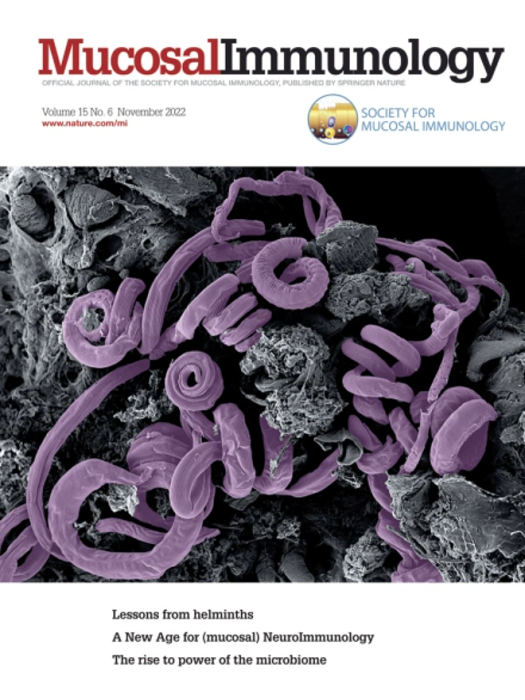Single cell transcriptional analysis of human adenoids identifies molecular features of airway microfold cells
IF 7.6
2区 医学
Q1 IMMUNOLOGY
引用次数: 0
Abstract
The nasal, oropharyngeal, and bronchial mucosa are primary contact points for airborne pathogens like Mycobacterium tuberculosis (Mtb), SARS-CoV-2, and influenza virus. While mucosal surfaces can function as both entry points and barriers to infection, mucosa-associated lymphoid tissues (MALT) facilitate early immune responses to mucosal antigens. MALT contains a variety of specialized epithelial cells, including a rare cell type called a microfold cell (M cell) that functions to transport apical antigens to basolateral antigen-presenting cells, a crucial step in the initiation of mucosal immunity. M cells have been extensively characterized in the gastrointestinal (GI) tract in murine and human models. However, the precise development and functions of human airway M cells are unknown. Here, using single-nucleus RNA sequencing (snRNA-seq), we generated an atlas of cells from the human adenoid and identified 26 unique cell types representing basal, club, hillock, and hematopoietic lineages, defined their developmental trajectories, and determined cell-cell relationships. Using trajectory analysis, we found that human airway M cells develop from progenitor club cells and express a gene signature distinct from intestinal M cells. Surprisingly, we also identified a heretofore unknown epithelial cell type demonstrating a robust interferon-stimulated gene signature. Our analysis of human adenoid cells enhances our understanding of mucosal immune responses and the role of M cells in airway immunity. This work also provides a resource for understanding early interactions of pathogens with airway mucosa and a platform for development of mucosal vaccines.
人腺样体单细胞转录分析鉴定气道微褶细胞的分子特征。
鼻、口咽和支气管粘膜是空气传播病原体如结核分枝杆菌(Mtb)、SARS-CoV-2和流感病毒的主要接触点。虽然粘膜表面可以作为感染的入口和屏障,但粘膜相关淋巴组织(MALT)促进对粘膜抗原的早期免疫反应。MALT包含多种特化上皮细胞,包括一种称为微褶细胞(M细胞)的罕见细胞类型,其功能是将根尖抗原转运到基底外侧抗原呈递细胞,这是启动粘膜免疫的关键步骤。在小鼠和人类的胃肠道模型中,M细胞已经被广泛地表征。然而,人类气道M细胞的确切发育和功能尚不清楚。在这里,我们使用单核RNA测序(snRNA-seq),生成了来自人类腺样体的细胞图谱,并鉴定了26种独特的细胞类型,代表了基础、俱乐部、丘和造血谱系,定义了它们的发育轨迹,并确定了细胞-细胞关系。通过轨迹分析,我们发现人类气道M细胞由祖俱乐部细胞发育而来,并表达与肠道M细胞不同的基因特征。令人惊讶的是,我们还发现了一种迄今未知的上皮细胞类型,显示出强大的干扰素刺激基因特征。我们对人腺样细胞的分析增强了我们对粘膜免疫反应和M细胞在气道免疫中的作用的理解。这项工作也为了解病原体与气道粘膜的早期相互作用提供了资源,并为开发粘膜疫苗提供了平台。
本文章由计算机程序翻译,如有差异,请以英文原文为准。
求助全文
约1分钟内获得全文
求助全文
来源期刊

Mucosal Immunology
医学-免疫学
CiteScore
16.60
自引率
3.80%
发文量
100
审稿时长
12 days
期刊介绍:
Mucosal Immunology, the official publication of the Society of Mucosal Immunology (SMI), serves as a forum for both basic and clinical scientists to discuss immunity and inflammation involving mucosal tissues. It covers gastrointestinal, pulmonary, nasopharyngeal, oral, ocular, and genitourinary immunology through original research articles, scholarly reviews, commentaries, editorials, and letters. The journal gives equal consideration to basic, translational, and clinical studies and also serves as a primary communication channel for the SMI governing board and its members, featuring society news, meeting announcements, policy discussions, and job/training opportunities advertisements.
 求助内容:
求助内容: 应助结果提醒方式:
应助结果提醒方式:


